Équipe de recherche
Nanophysics and Semiconductors
NPSC explores new physical phenomena, related to photons, electrons and spin, at quantum scale, in II-VI and III-V semiconductors nanostructures
NPSC Team

Latest news
Introduction
The team Nanophysics and Semiconductors (NPSC) is not only one of the research team at Institut NEEL, but it is also a joint research group between Institut NEEL-CNRS and IRIG-CEA (previously INAC-CEA). The history of the team goes back to 1986: a joint team CNRS-CEA, involving altogether about 10 researchers, was created at that time to develop the Molecular-beam epitaxy (MBE) growth of II-VI semiconductors. Over the years, the focus and size of the team has enlarged and its name changed. The joint team NPSC has now about 65 members including PhD students and postdocs. Among the permanent researchers of the joint team, 18 are affiliated to Institut NEEL, 10 are affiliated to CEA-IRIG.
NPSC mainly focuses on fundamental research in nanoscience, exploring new physical phenomena, and sometimes their potential applications, related to quantum confinement in low-dimensional II-VI and III-V semiconductor heterostructures. These studies rely on research activities dedicated both to the fabrication and to the physical studies of high-quality samples. The expertise of the team is based on arsenide, nitride, selenide and telluride compounds, using advanced epitaxial techniques (MBE, metal organic chemical vapor deposition MOCVD), technological processing, structural characterization, as well as state-of-the-art optical spectroscopy setups. The activity is also supported by theoretical developments in quantum mechanics.
In recent years, our research has included for instance the growth of nanowires made of different compounds, the development of materials emitting from THz to UV, as well as semiconductor QDs for single photon emission or single spin manipulation. We aim at mastering not only specific emitters but also their photonic environment for novel optoelectronics devices. We are particularly interested in single spin manipulation, efficient single photon sources, and coherence in quantum optics.

Tools and methods
Molecular beam epitaxy (MBE) chambers (located at CEA, building C5)
- Nitrides (2 chambers)
- Tellurides and Sellenides (II-VI)
- Arsenides
- Metal organic chemical vapor deposition (MOCVD) for nitrides
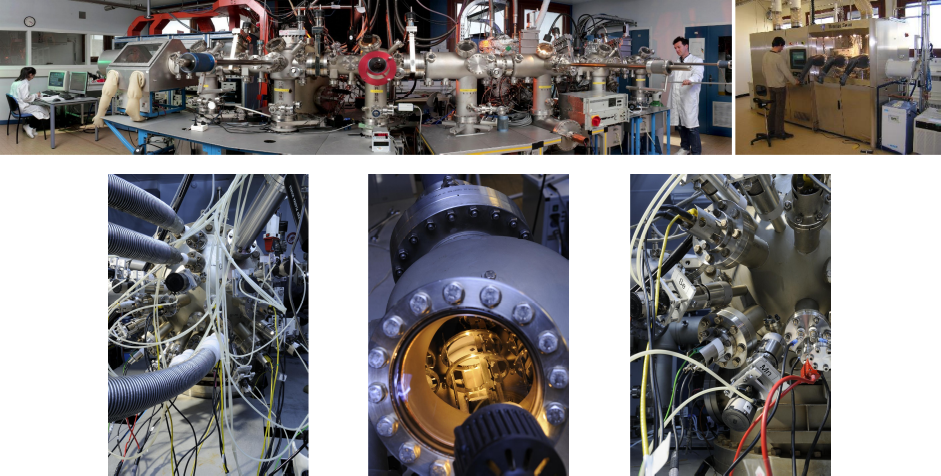
Optical spectroscopy setups
- from Ultraviolet to Infrared
- magneto-optics
- micro-photoluminescence
- time-resolved spectroscopy (ps)
- quantum optics
- four-wave mixing
Other expertise
- Nanofabrication: Néel Nanofab platform and Plateforme Technologique Amont (PTA) CEA-Grenoble
- Microscopy: Transmission electron microscope (TEM), Scanning electron microscope (SEM)
- Cathodoluminescence
- X-ray diffraction
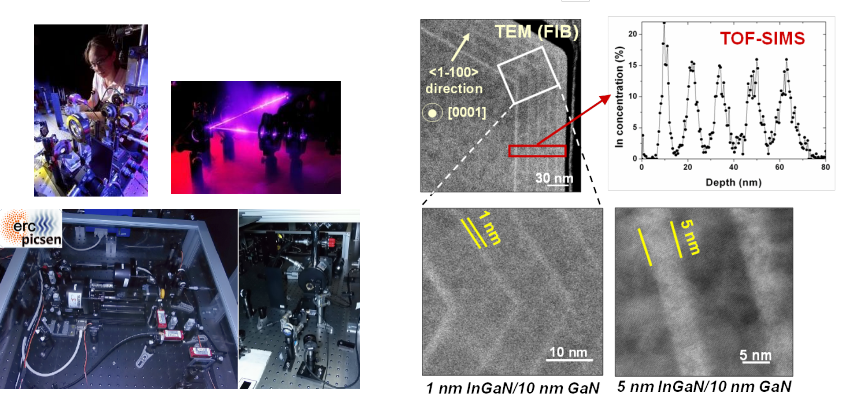
Epitaxy of semiconductors
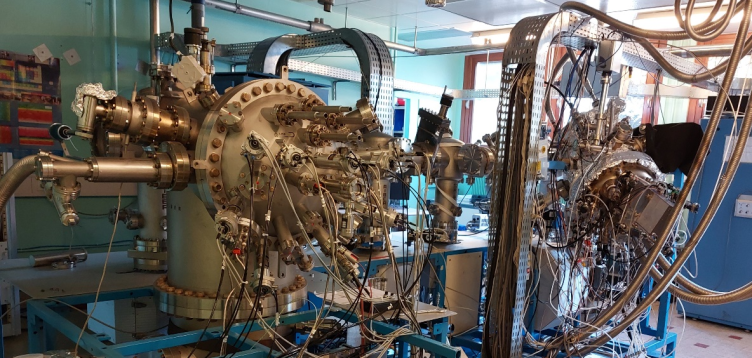
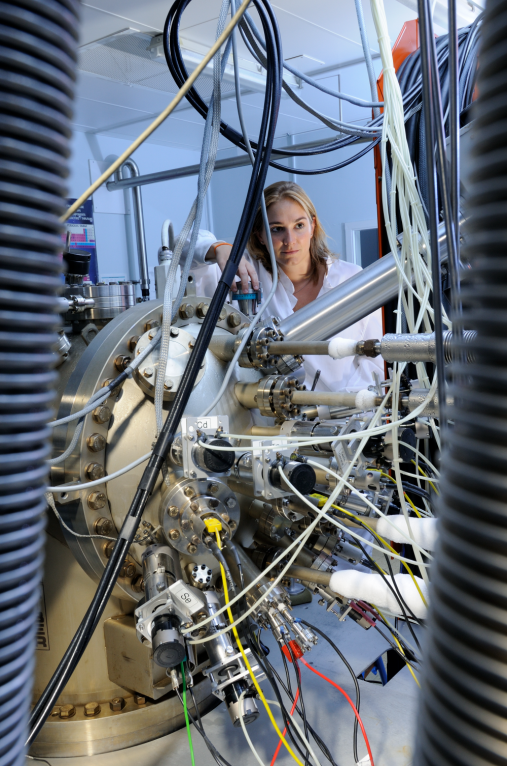 NPSC has a long-standing expertise in the field of epitaxy of semiconductor materials and heterostructures. Our activities are of two kinds: (i) research into the physics of epitaxy by itself, and (ii) development of materials of interest to tackle new phenomena in the field of condensed matter physics, usually for fundamental research but also with an interest for possible applications.
NPSC has a long-standing expertise in the field of epitaxy of semiconductor materials and heterostructures. Our activities are of two kinds: (i) research into the physics of epitaxy by itself, and (ii) development of materials of interest to tackle new phenomena in the field of condensed matter physics, usually for fundamental research but also with an interest for possible applications.
The team is equipped with an ensemble of six Molecular Beam Epitaxy chambers (MBE) and one Metal-Organic Chemical Vapour Deposition machine (MOCVD). Those equipments can cover a wide range of materials (arsenides, tellurides, selenides, nitrides and oxides) known to interact with light from IR to UV, for quantum optics and nano-photonics, or for their specific transport properties, from fundamental topological aspects to power electronics.
To go further, with our know-how we use epitaxy to develop semiconductor objects of various dimensionalities (quantum dots, nanowires, quantum wells, 2D materials), complex epitaxial interfaces between compounds who have no atoms in common, and materials in unstable phases.
Finally, among our motivations for growing semiconductors objects, the idea of “single object”, of “localization” or “confinement” is often central: localization of a spin (on a single impurity), confinement or charge carriers (at the nanometer scale) and/or confinement of photons (at the micrometer scale), integrating notions such as quantum dots or quantum wells with microcavities or photonic wires.
Spintronics with diluted magnetic semiconductors
Concerning the control of spins in semiconductors, over the period, different objects were developed and studied, including single spin systems or Diluted Magnetic Semiconductors (DMS): (i) strain free Mn-doped QDs (ii) Mn-doped self-assembled QDs charged with a single hole, (iii) Cr-doped self-assembled QDs, (iv) DMS in nanowires QDs.
In strain free Mn-doped QDs, a spin system which does not present any magnetic anisotropy, we have studied the dynamics of coupled electronic and nuclear spins of a single atom and showed that a weak magnetic field has to be applied to suppress the electron-nuclei flip-flops and restore a Mn spin memory. This system is promising to study the coherent dynamics of a single nuclear spin in a solid-state environment. On the contrary, a hybrid hole-Mn spin presents a large magnetic anisotropy. This should be favorable to obtain a spin memory at zero field. However, we have demonstrated that hole-Mn has a spin relaxation in the 100 ns range induced by interplay of the hole-Mn exchange interaction and coupling to the strain field of acoustic phonons.
Cr incorporated in II-VI semiconductors carries an orbital momentum, and most of its isotopes have no nuclear spins. It is in that sense complementary to Mn. The orbital momentum connects efficiently the Cr spin to its strain environment through the crystal field and the spin-orbit coupling. This makes Cr a very promising qubit for the development of spin nano-mechanical systems. We have demonstrated the optical control of the spin of a Cr atom and studied its spin dynamics. We are now developing devices for a coherent mechanical driving of a Cr spin with surface acoustic waves.
The research activity on II-VI DMS nanowire heterostructures continued with the main goal to stabilize a light hole ground state in elongated magnetic quantum dots. The ANR project ESPADON (coordinated by the team), in collaboration with C2N and IRIG, is based on: the MBE growth of quantum dots along nanowires, (ii) their structural characterization, magneto-optical spectroscopy and numerical simulations. The growth of CdMnTe-ZnTe nanowire quantum dots with different aspect ratio (length over diameter ratio ranging from 0.5 to 2) has been studied extensively revealing the critical growth temperature window for quantum dot insertion. Single dot spectroscopy (cathodo-luminescence, microphotoluminence) has been performed with samples previously characterized by structural techniques, Scanning Transmission Electron Microscopy (STEM), Energy Dispersive X ray spectroscopy in collaboration with the MRS team (M. Den Hertog), and CEA-IRIG (E. Robin). Magneto-optical spectroscopy and Fourier microscopy carried out on quantum dots having an aspect ratio about 2 revealed the presence of a light-hole ground state in the dot. These experimental results were found to be in good agreement with 6 band k.p advanced numerical simulations (strain, electronic properties, Zeeman effect) developed in collaboration with CEA-IRIG (Y.-M. Niquet).
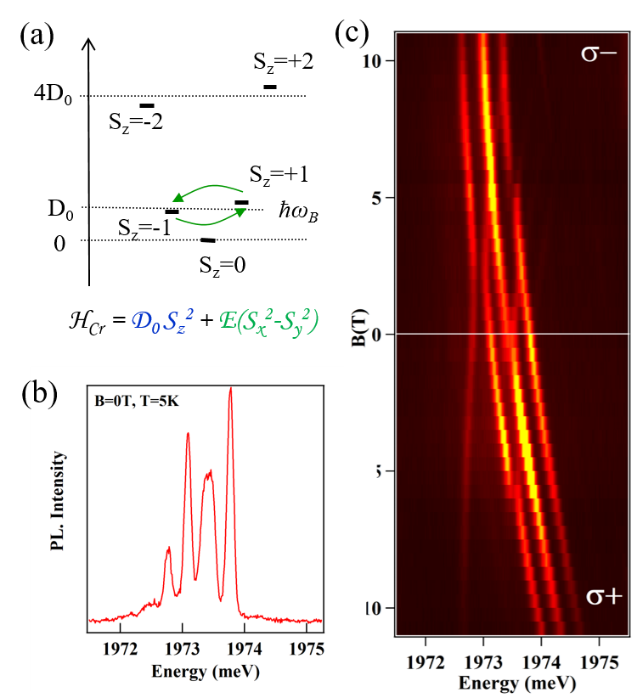
(a) Energy levels of a Cr spin embedded in a CdTe/ZnTe QD submitted to a longitudinal magnetic field (B) and biaxial strain. The Cr spin level distribution is dominated by a large magnetic anisotropy (D0Sz2). In addition, an anisotropic in-plain strain (E(Sx2-Sy2)) couples spin states Sz=+1 and Sz=-1 whose splitting can be controlled by B. (b) Circularly polarized PL spectra of an individual CdTe/ZnTe QD containing a single Cr atom. (c) PL intensity map of a Cr-doped QD versus magnetic field. Only the Cr spin states Sz=0 and Sz=±1 are observed.
References:
- A. Lafuente et al., Individual Cr atom in a semiconductor QD: Optical addressability and spin-strain coupling, Phys. Rev. B 93, 161301 (2016).
- A. Lafuente et al., Resonant optical control of the spin of an individual Cr atom in a QD, Phys. Rev. B 95, 035303 (2017).
- A. Lafuente et al., Resonant PL and dynamics of a hybrid Mn-hole spin in a positively charged magnetic QD, Phys. Rev. B 95, 245308 (2017).
- A. Lafuente et al., Dynamics of a Cr spin in a semiconductor QD: Hole-Cr flip-flops and spin phonon coupling, Phys. Rev. B 97, 155301 (2018).
Quantum Optics and Optomechanics
Quantum optics
Optical nonlinearities usually appear for large intensities, but discrete transitions allow for giant nonlinearities operating at the single-photon level. We have demonstrated a two-mode giant nonlinearity with a single semiconductor quantum dot (QD) embedded in a photonic wire antenna. We have exploited two detuned optical transitions associated with the exciton-biexciton QD level scheme. Owing to the broadband waveguide antenna, the two transitions were efficiently interfaced with two free-space laser beams. We have shown [1] that the reflection of one laser beam can be controlled by the other beam, with a threshold power as low as 10 photons per exciton lifetime (1.6 nW). Such a two-color nonlinearity opens appealing perspectives for the realization of ultralow-power logical gates and optical quantum gates, and could also be implemented in an integrated photonic circuit based on planar waveguides.
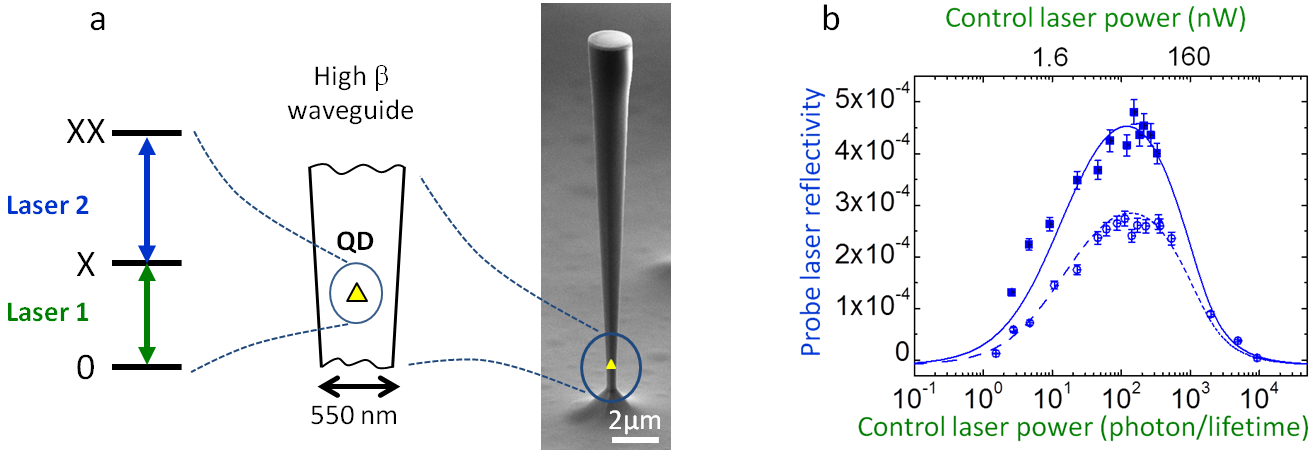
Fig.1: a, A single InAs QD embedded in a GaAs waveguide. The thre-level system is made of the excitonic (X) and the biexcitonic (XX) transitions.The β parameter is the fraction of light emitted by the QD that is guided by the wire. b, The probe (upper transition) reflectivity is displayed as a function of the control (lower transition) power for a probe power of 0.5 nW (solid squares) and 2.6 nW (empty circles).
References:
- [1] H.A Nguyen, T. Grange, B. Reznychenko, I. Yeo, P.-L De Assis, D. Tumanov, F. Fratini, N. Malik, E. Dupuy, N. Gregersen, A. Auffèves, J.-M. Gérard, J. Claudon, J.-Ph. Poizat, Giant non-linear interaction between two optical beams via a quantum dot embedded in a photonic wire, Phys. Rev. B 97, 201106(R) (2018).
Optomechanics
Hybrid quantum optomechanical systems offer an interface between a single two-level system and a macroscopical mechanical degree of freedom.
One of the major objectives for developing this concept is the realization of a quantum interface between a qubit and a mechanical oscillator with important technological applications for quantum information and ultra-sensitive measurements
We have built a hybrid system made of a vibrating microwire coupled to a single semiconductor quantum dot (QD) via material strain. We have shown a few years ago, that the QD excitonic transition energy can thus be modulated by the microwire motion [1] (cf Fig.2a,b). We have used this property to locate very precisely QD within the microwire [2] (cf Fig.2c).
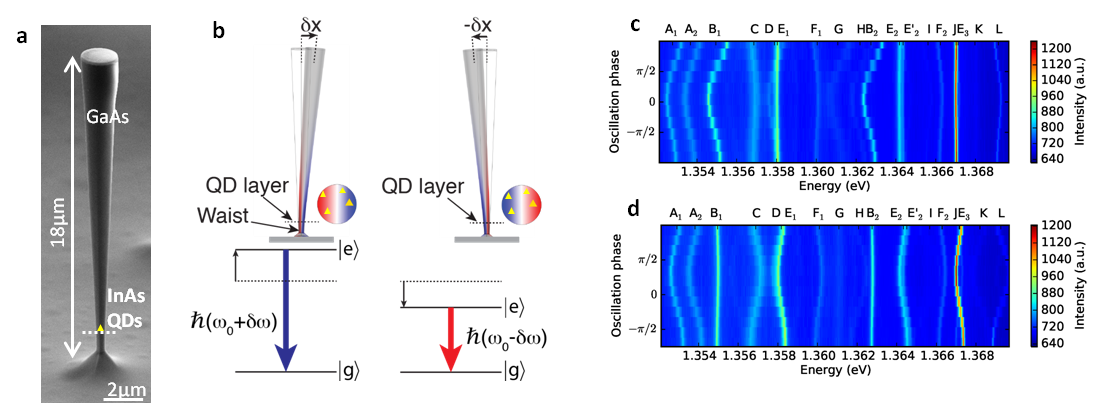
Fig. 2 a, Scanning electronic microscope image of the photonic wire. b, The strain field (color scale) induced by the wire oscillation shifts the quantum dot energy. c,d, Stroboscopic data showing the energy shift for different QDs as the wire oscillates along the X (Y) polarized mode in c (d).
Following a theoretical proposal [3], we have demonstrated the reverse effect whereby the wire is set in motion by the resonant drive of a single QD exciton with a laser modulated at the mechanical frequency [4] (Fig. 3). The resulting driving force is found to be almost 3 orders of magnitude larger than radiation pressure.
From a fundamental aspect, this state dependent force offers a convenient strategy to map the QD quantum state onto a mechanical degree of freedom.
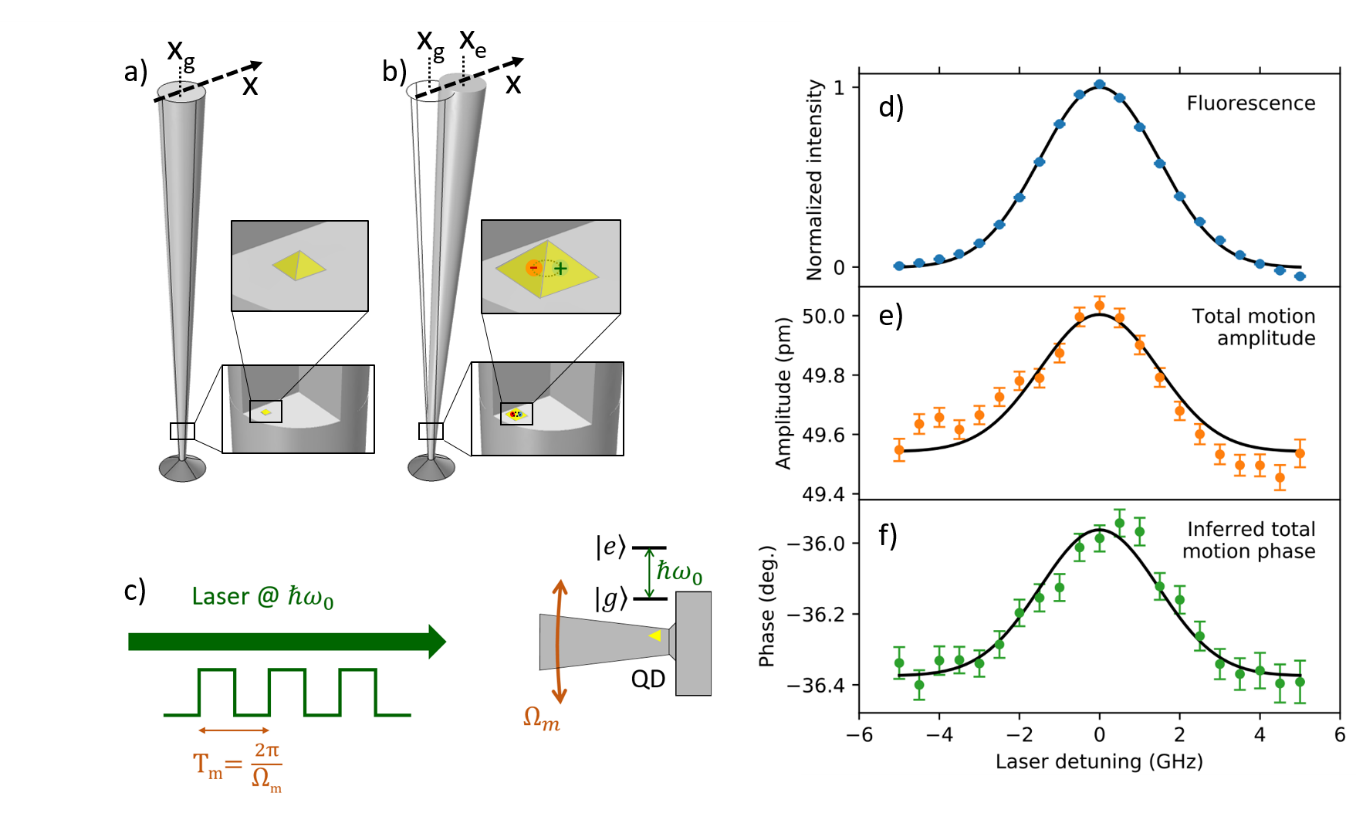
Fig. 3 a,b Schematic explanation of the effect. The lower insets are a cut of the wire showing the approximate position of the QD (yellow pyramid). When the QD is in its ground state (in a), the wire rest position is xg. When the QD is excited (hosts an exciton, represented as an orange electron and a green hole in b), its physical size is larger so that the rest position of the wire is displaced to xe. c, Principle of the experiment. The QD is illuminated by a laser resonant with its optical transition at ω0. The laser intensity is modulated at the wire mechanical frequency Ωm/2 and the wire motion is measured as a function of the laser detuning with respect to the QD transition. d, fluorescence light emitted by the QD as the laser is scanned across the QD resonance. Corresponding amplitude (e) and phase shift (f) of the wire motion, demonstrating the QD induced motion.
References:
- [1] I. Yeo, et al, Strain-mediated coupling in a quantum dot-mechanical oscillator hybrid system, Nature Nanotechnology 9, 106 (2014).
- [2] P.L. de Assis, et al, Strain-gradient position mapping of semiconductor quantum dots, Phys. Rev. Lett. 118, 117401 (2017).
- [3] A. Auffèves and M. Richard, Optical driving of macroscopic mechanical motion by a single two-level system, Phys. Rev. A 90, 023818 (2014) .
- [4] J. Kettler, N. Vaish, L. Mercier de Lépinay, B. Besga, P.L. de Assis, O. Bourgeois, A. Auffèves, M. Richard, J. Claudon, J.M. Gérard, B. Pigeau, O. Arcizet, P. Verlot, and J.P. Poizat, Inducing micromechanical motion by optical excitation of a single quantum dot, Nature Nanotech. 16, 283–287 (2021)
Light-matter interactions in solid-state nanostructure
The degree of control in light-matter interaction in solids is ever increasing, bringing about a vast field of new resources both for new applications and for addressing new fundamental issues. Exciton-polaritons for instance can be viewed as interacting photons, stored in the spacer of a semiconductor microcavity, that exhibit all the features of a nonequilibrium quantum fluid. We examine the thermodynamical properties of this exotic fluid: its ability to conduct, capture and dissipate heat, and its ability to produce work under the form of a coherent phonon field.

Artist view of the experimental setup: The incoming classical laser light travels through the optical fiber (top of the image) and enters in the cavity (red beam). The indentation at the output surface of the fiber is the cavity spherical mirror of a few tens of microns of curvature. The bottom structure consists of a quantum well (white layer) and a flat Bragg mirror (alternative dark blue/cyan layers). Owing to the polariton blockade effect, the transmitted light is closer to the quantum (Fock) state n=1 (bottom of image).
References:
- P. Senellart et al., Nat. Nanotechnol. 12, 1026 (2017).
- E. Urban et al., Nat. Phys. 5, 110 (2009).
- I. Carusotto et al., Rev. Mod. Phys. 85, 299 (2013).
- A. Verger et al., Phys. Rev. B 73, 193306 (2006).
- A. Delteil et al., Nature Materials 18, 219 (2019).
- G. Muñoz-Matutano et al., Nature Materials 18, 213 (2019).
Other means of control are provided by using metallic nanostructures sustaining plasmonics modes. We develop top-down nanofabrication processes for coupling metallic nanoantennas to semiconducting nanowires produced by our team or non-linear nanocrystals, in the frame of an active collaboration with the NOF and OPTIMA teams. The nanoscale control allows designing hybrid nanostructures that can strongly enhance for example the second-harmonic generation or the emission of rare-earth luminescent centers as more recently considered.
Quantum foundations and quantum thermodynamics
We develop a new interpretation for quantum mechanics that is based on contextual objectivity and quantization. This leads, e.g., to original views on the origin of randomness and to the development of new concepts in quantum thermodynamics.
We establish a new research area on the study of quantum causality. Here the objective is to study the new types of causal relations that may exist in the quantum world. Indeed, quantum causal relations may have genuinely quantum features, and may be subject to similar quantum indefiniteness as quantum states: one can, e.g., find some “quantum superpositions of causal relations”. Along this line of research, we investigate a new framework that allows one to study quantum processes without imposing a well-defined causal structure; we clarify the concepts of interest and how to verify them in practice. We contribute to experimental demonstrations of such processes, and investigate their possible applications for quantum information processing.
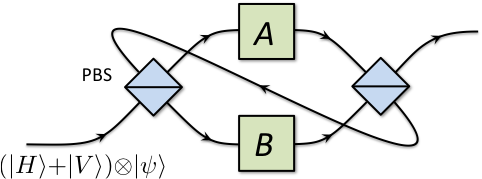
A photonic implementation of the “quantum switch”: the polarisation ( |H> or |V> ) of a photon controls its trajectory through the above setup (via polarising beamsplitters, PBS, which transmit |H> and reflect |V>): a |H> photon first goes to A and then to B, and vice-versa for a |V> photon, where A and B are quantum operations applied to the state |Ψ> of another degree of freedom of the photon (e.g., the orbital angular momentum, as in the Brisbane experiment). A photon in a superposition |H>+|V> thus undergoes a superposition of the two orders AB and BA.
References:
- M. Araújo, C. Branciard, F. Costa, A. Feix, C. Giarmatzi, and Č. Brukner, Witnessing causal nonseparability, New Journal of Physics 17, 102001 (2015).
- K. Goswami, C. Giarmatzi, M. Kewming, F. Costa, C. Branciard, J. Romero, and A. G. White, Indefinite Causal Order in a Quantum Switch, Physical Review Letters 121, 090503 (2018).
We also investigate other aspects of the “quantum weirdness”, related in particular to the uncertainty principle, to the status of the wave function in quantum theory, to quantum entanglement and to quantum (or even post-quantum) nonlocality.
Regarding thermodynamics, we work on the energetic footprints of quantum noise and information. The essence of classical thermodynamics at the microscopic scale is to extract energy from hot baths and convert it into useful energy (work), turning thermal noise into a resource. Reciprocally, thermodynamics provides fundamental concepts to estimate the energetic cost of fighting against noise to maintain order. Since information is stored in physical systems, it also obeys the laws of thermodynamics.
Our goal is to transpose the concepts and tools of (information) thermodynamics to the case where noise and information become quantum. On the one hand, this allows designing realistic nano-engines with no classical equivalent (e.g. coherence or quantum measurement driven engines, autonomous quantum Maxwell’s demons…) with clear quantum boosts and genuine quantum operating modes. The studies are conducted in collaboration with cutting edge experimentalists, on platforms with exquisite quantum control: semi-conducting quantum dots deterministically coupled to high Q cavities, superconducting circuits, Rydberg atoms. A complementary axis consists in bridging the gap between optomechanical systems and quantum thermodynamics, owing to the potential of these systems for direct measurement of work exchanges.
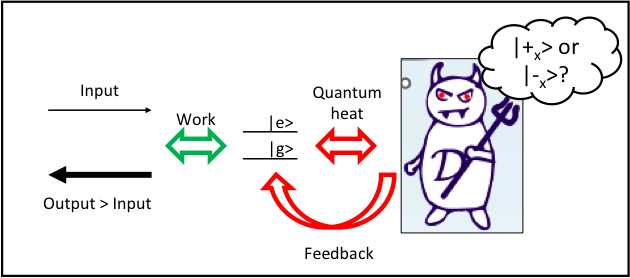
Schema of a quantum Maxwell’s-daemon experiment. The qubit states (|g>, |e>) and a driving field exchange work with each other, while it is being periodically measured by the daemon in the {|+x>, |-x>} basis. Each time the daemon measures |-x>, it performs a feedback on the qubit to bring it into the state |+x>, the state which is favourable for extracting work from the qubit.
References:
- C. Elouard, D. Herrera-Marti, B. Huard, A. Auffèves, PRL 118, 260603 (2017),
- C. Elouard, D. Herrera-Marti, M. Clusel, A. Auffèves, npjQI 3:9 (2017).
2D-materials and four wave mixing spectroscopy
Monolayers (MLs) of transition metal dichalcogenides (TMDs), like {Mo,W}{S,Se,Te}2, are direct bandgap semiconductors displaying many intriguing properties. Apart from their intrinsic two-dimensional character, they host excitons with binding energy exceeding 10% of their bandgap – nearly 2 orders of magnitude more than in standard semiconductors, like GaAs. This, combined with the band structure generating spin-valley locking of excitons, has driven an intense research, also as regards their optical response. In particular, the spectral lineshape and spectral width are usually dominated by the inhomogeneous broadening due to such disorder. In recent years, we have used the four-wave mixing microscopy (FWM) setup that we developed, to accurately measure homogeneous and inhomogeneous broadenings of bare TMD MLs. Thanks to the microscopy configuration, we could perform spatial imaging of both quantities and indicated their correlations, revealing a general link between the exciton coherence volume, governed by the disorder, and its radiative rate, which can be read from the homogeneous linewidth.
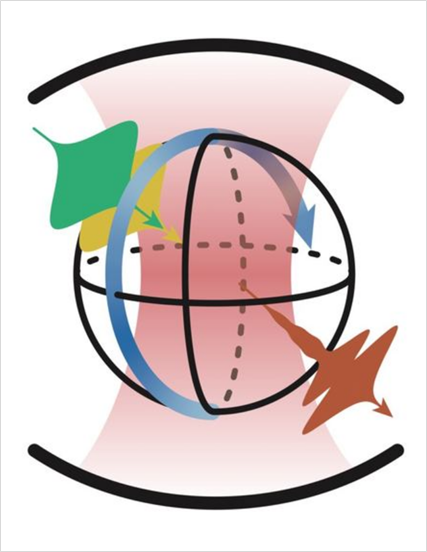
A single emitter in a solid is a two-level quantum system. Its state can be represented on a Bloch sphere, carrying information about its coherence (degree of quantum superposition between the ground and excited state). The emitter, here a quantum dot exciton, is driven by a pair of short resonant laser pulses (green and yellow), to produce four-wave mixing signal (red). By measuring the amplitude of the latter as a function of the delay between the former ones, we measure the coherence dynamics on a timescale from 100fs to 1ns. By enclosing the quantum dot inside a photonic structure (here, illustrated with a cavity) one enhances the four-wave mixing extraction efficiency by several orders of magnitude, principally thanks to the suppressed background originating from the resonant excitation.
References:
- F. Fras et al. Multi-Wave Coherent Control of a Solid State Single Emitter, Nature Photonics 10, 155 (2016).
- Q. Mermillod et al. Dynamics of excitons in individual InAs quantum dots revealed in four-wave mixing spectroscopy Optica 3, 377 (2016).
- Q. Mermillod et al. Harvesting, coupling and control of single exciton coherences in photonic waveguide antennas Physical Review Letters 116, 163903 (2016).
- D. Wigger et al. Rabi oscillations of a quantum dot exciton coupled to acoustic phonons: coherence and population readout. Optica 5, 1442 (2018).
III-V compound semiconductor nanowires heterostructures for quantum technologies
In the team, we develop nanowires based on GaAs and InAs semiconductors. InAs and GaAs can be combined in heterostructures to form quantum dots. We use those quantum dots for single photon emission applications.
Our InAs nanowires are also combined with superconductors to form core shell heterostructures. They are integrated into quantum devices such as gatemon quantum bits or into devices designed to search for exotic particles that live in topological superconductors.
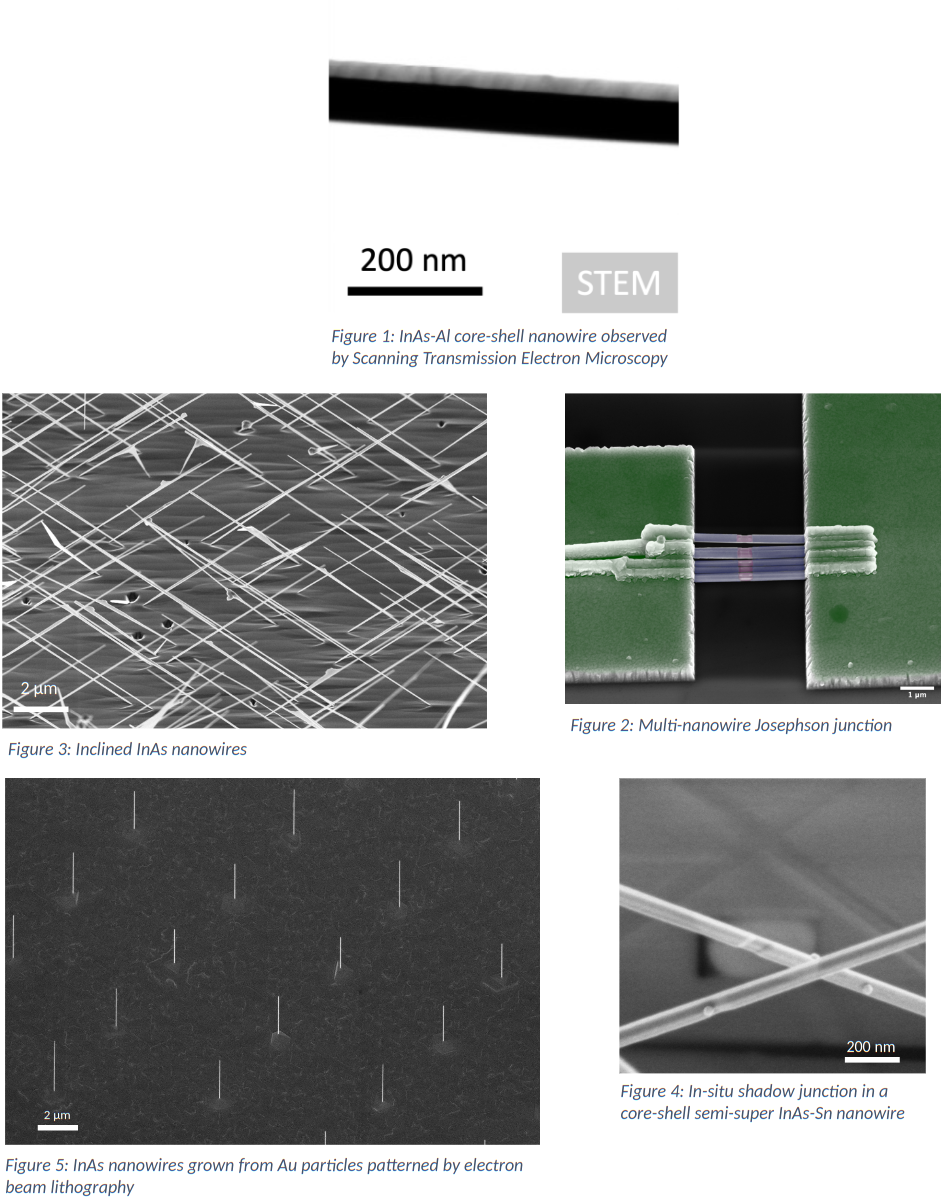
Alumnis
2023 post-doc – PICCIONE Nicolo
2023 thèse – GAIGNARD Maxime
2023 thèse – GOES Bruno
2023 post-doc – MAFFEI Maria
2022 thèse – BRESQUE Léa
2022 post-doc – WEIN Stephen
2022 post-doc – NAHRA Mackrine
2022 thèse – CHEN An-Hsi
2022 post-doc – DARDAILLON Rémi
2022 thèse – LAZOURENKO-DOURDENT Hippolyte
2022 thèse – LETERTRE Laurie
2021 thèse – FELLOUS-ASIANI Marco
2021 thèse – VINCENTE Rémi
2021 thèse – TIWARI Vivekanand
2021 thèse – KLOSS Enzo
2020 post-doc – CAMATI Patrice
2020 post-doc – MARIANI Cristian
2020 thèse – WECHS Julian
2019 thèse – MONSEL Juliette
2019 thèse – MORATIS Kimon
2019 thèse – VAISH Nitika
2019 thèse – JALOUSTRE Lucas
2018 thèse – REZNYCHENKO Bogdan
2018 post-doc – ABBOTT Alastair
2018 post-doc – KETTLER jan
2018 thèse – LAFUENTE-SAMPIETRO Alban
2018 thèse – BEZNASYUK Daria
2017 thèse – ELOUARD Cyril
2017 thèse – DELMONTE Valentin
2017 post-doc – JAKUBCZYK Tomasz
2017 post-doc – DE-ASSIS Pierre-Louis
2017 thèse – TUMANOV Dmitrii
2017 thèse – ORRU Marta
2016 thèse – JEANNIN Mathieu
2016 post-doc – TAN Siew-li
2016 thèse – NGUYEN Hoai-anh
2016 post-doc – FERRARI Alberto
2016 thèse – ARTIOLI Alberto
2015 post-doc – GRANGE Thomas
2015 post-doc – VACANTI Giovani
2015 thèse – MERMILLOD Quentin
2015 post-doc – KLEMBT Sebastian
2015 thèse – RUEDA-FONSECA Pamela
2013 thèse – ELOUNEG-JAMROZ Myriam
2013 thèse – GERARD Lionel
2013 thèse – STEPANOV Petr
2012 thèse – BOUNOUAR Samir
2012 thèse – CAO Chong long
2012 thèse – DINIZ Igor
2012 thèse – TRICHET Aurélien
2012 thèse – VALENTE Daniele
2012 thèse – YEO Inah
2012 post-doc – BRUNETTI Adalberto
2012 post-doc – FRAS François
2012 post-doc – MEDARD François
2011 thèse – LE GALL Claire
2011 post-doc – PORTOLAN Stephano
2010 thèse – YU Ing-Song
2010 post-doc – WOJNAR Piotr
2010 post-doc – KOLODKA Roman
2009 thèse – CLEMENT Thomas
2009 thèse – MUNSCH Mathieu
2009 thèse – SALLEN Gregory
2008 thèse – NAJJAR Rita